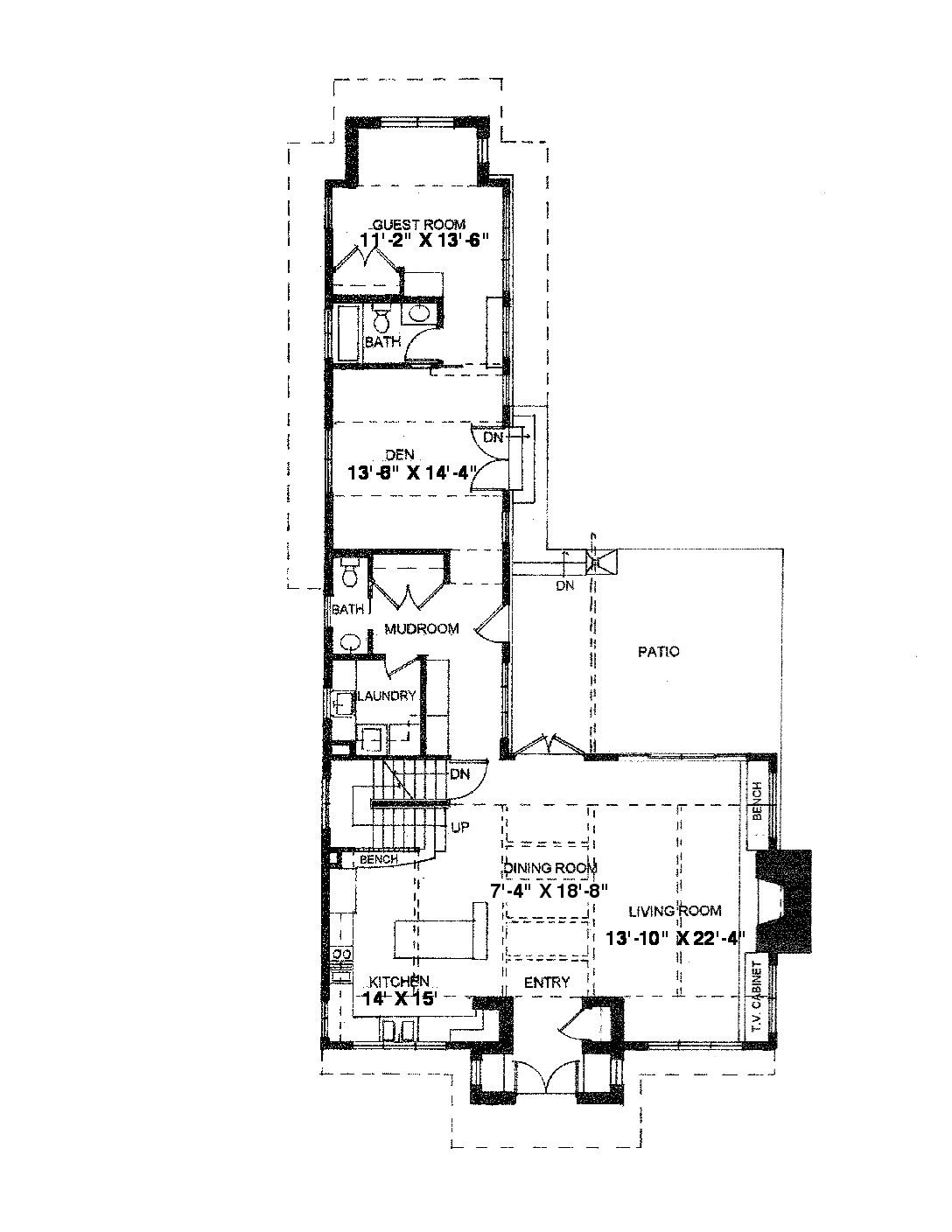
Main Level Floor Plans For Urban Bungalow
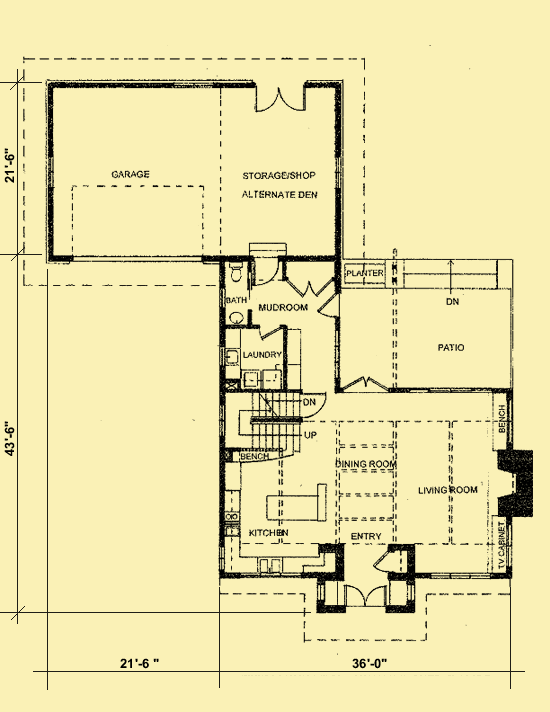
Upper Level Floor Plans For Urban Bungalow
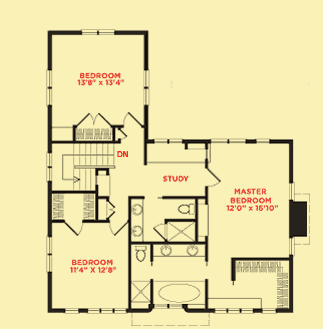
Floor Plans 1 For Urban Bungalow
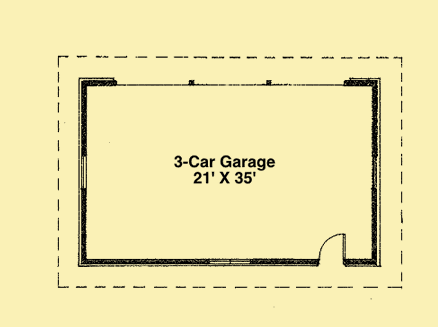
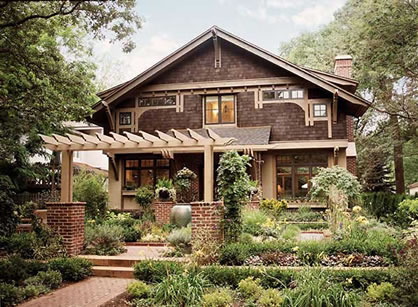
| Total Above-ground living area | 2880 |
| Main Level | 1700 |
| Upper Level | 1180 |
| Lower level living area | 1160 |
| Footprint The dimensions shown are for the house only (indicating the smallest area needed to build). They do not include the garage, porches, or decks, unless they are an integral part of the design. |
36 W x 68.667 D |
| Above-ground bedrooms | 3 - 4 |
| Above-ground bathrooms | 3.5 |
| Master suite | Upper |
| Lower-level bedrooms | 0 |
| Lower-level bathrooms | 0 |
| Stories | 2 |
| Parking | garage |
| Number of stalls | 3 |
| House height
Traditionally, the overall height of a house is determined by measuring from the top of the finished floor on the main level, to the highest peak of the roof.
|
26.5 |
| Ceiling heights Raising or lowering the height of the ceilings on one or more floors of a house is often a simple change that can be made by your builder. However, if you want to raise the ceiling of the main floor of a two-story home, there has to be room to add steps to the existing staircase. |
|
| Main level | 9.333 |
| Upper level | 8.5 |
| Vaulted ceilings
We consider a room to be vaulted if the ceiling - whether flat, angled, or curved - is above 10 feet at its highest point. If you prefer that one or more rooms not be vaulted in your new home, this is a very simple change that your builder can make for you.
KEY TO SYMBOLS: LR = Living Room/Great Room DR = Dining Room FAM = Family Room FOY = Foyer STU = Study/Library/Den KIT = Kitchen SUN = Sunroom MBR = Master Bedroom MB = Master Bath LOF = Loft OFF = Office/Guest Room REC = Recreation/Game Room ALL = Entire Level |
|




Urban Bungalow is featured in architect Michaela Mahady’s new book, “Welcoming Home”. You can find more information about the book and about purchasing the book at Amazon.com if you click on the book cover.
Inspired by the beautiful bungalows built in Chicago during the Arts and Crafts movement, this contemporary Illinois home contains all the classic features and beauty of the Craftsman style. Designed by Michaela Mahady (the architect who designed our most popular home, the Maple Forest) and Debra Kees of SALA Architects, the house may be built in stages over time, allowing greater flexibility for a growing family. This house can be easily modified to include a full in–law unit on the main floor. If this is of interest to you, please read the section near the end of this Description titled In–Law Unit. It can also be easily modified to include a formal dining room. If this is of interest to you, please read the section near the end of this Description titled Modification Idea.
It ranges in size from 2397 square feet to 2880 square feet, and is designed to be able to fit on a narrow urban lot. As Michaela says, “The modest size of the cottage with its low–pitched roof, gabled facade, horizontal bands of windows, and rich Craftsman detailing, help it fit into its neighborhood.” However, a good percentage of our customers have built this house in more rural settings.
As you come off the covered porch, you enter a foyer with a bench, built–in cabinetry, and a coat closet. As you enter the living space, an open beamed ceiling connects the living room, dining area, and kitchen. The living room features a central fireplace hearth, flanked by built–ins and window benches on either side. Glazed windows line the rear wall to bring in sunshine and views to and through the backyard patio. The “L” shaped plan allows more windows to the outdoor garden space, and brings in more natural light to the interior. The finely crafted stairwell wraps into the kitchen space, creating a built–in bench for sitting and relaxing.
As you go down the hall to the rear of the house, you pass a laundry room, a half bath, a mudroom with built–ins, and a door that opens onto the patio space. At the rear of the house, there is an open den space, a full bathroom, and a guest room. Depending on your needs, you may choose to build the rear of the house in phases, or choose not to build it at all. Drawings for a detached garage are included, so another option is to build an attached garage at this location instead.
Upstairs, the stairwell landing is oversized, creating a nook for a study area or for reading. A master bedroom with a walk–in closet and full bath, and two more bedrooms with a shared full bath are located here. An arched ceiling at the landing continues through both of the bathrooms, with interior glass visually threading the rooms together, as well as bringing in natural light.
In–Law Unit
Use the bedroom and the den on the main floor as an in–law unit by adding a door between the den and the rest of the house.
Modification Idea
Some of our customers are not comfortable with having the dining area positioned between the kitchen and the living room (although this is exactly what the original homeowners wanted), and others have expressed a desire to have a separate dining room. After studying the plans and consulting with the architect (who thinks it’s a great idea, even though it’s not what her clients wanted), we’ve come up with an incredibly easy way to create a formal dining room – and a larger living room – while adding no square footage! All you’d need to do is shift the laundry room, powder room and closet to where the den is currently located, and voila – there’s a 14’x 13’8″ formal dining room, close to the kitchen, with access and views to the patio.
If you don’t need the den or the bedroom beyond it (see the version of the floor plans with the attached garage), but would still like to have a dining room, this is an easy change to make as well. If you simply don’t construct the laundry room, powder room, and the extra coat closet in the space opposite the patio, this space becomes a room that can be used as a dining room (or a den). A wall could then be constructed at the far end of this room, with doors opening to a laundry room and a powder room at the rear of the house.
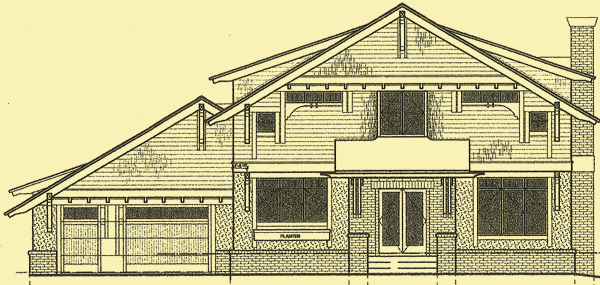
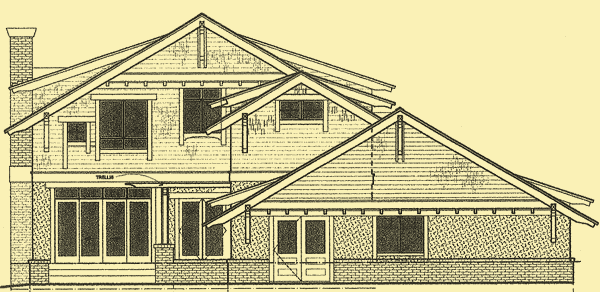

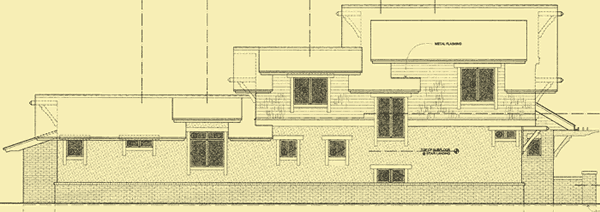



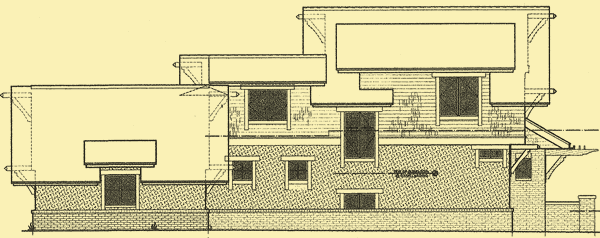
This classic bungalow features classic Craftsman–style wood detailing at the exterior that continues into the interior of the house. The plans include two versions – one with an extra bedroom and den on the main level, and one without them. Both versions have three bedrooms on the upper level. The living, dining and kitchen spaces are open to each other, and all enjoy a large fireplace and views to and through a trellised outdoor patio space.
We highly recommend that you click on two boxes – the number of bedrooms you know you need, and one less bedroom. For example, if you need 4 bedrooms, click on the boxes next to 4 and next to 3. Otherwise you will not see homes where existing rooms on the lower, main, or upper levels might work perfectly well as a bedroom instead of as an office, study, etc.
